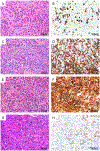Important Considerations in the Diagnosis and Management of Post-transplant Lymphoproliferative Disorder
- PMID: 37162742
- PMCID: PMC10390257
- DOI: 10.1007/s11912-023-01418-0
Important Considerations in the Diagnosis and Management of Post-transplant Lymphoproliferative Disorder
Abstract
Purpose of review: A relative lack of molecular and clinical studies compared to other lymphoid cancers has historically made it difficult to determine optimal management approaches in post-transplant lymphoproliferative disorder (PTLD). We sought to better define the "state of the science" in PTLD by examining recent advances in risk assessment, genomic profiling, and trials of PTLD-directed therapy.
Recent findings: Several major clinical trials highlight risk-stratified sequential therapy incorporating rituximab with or without chemotherapy as a rational treatment strategy in patients with CD20+ PTLD who do not respond to reduction of immunosuppression alone. Epstein Barr virus (EBV)-targeted cytotoxic lymphocytes are a promising approach in patients with relapsed/refractory EBV+ PTLD, but dedicated clinical trials should determine how autologous chimeric antigen receptor T cell therapy (CAR-T) may be safely administered to PTLD patients. Sequencing studies underscore the important effect of EBV infection on PTLD pathogenesis, but comprehensive genomic and tumor microenvironment profiling are needed to identify biomarkers that predict response to treatment in this clinically heterogeneous disease.
Keywords: Epstein-Barr virus; Hematopoietic stem cell transplant; Post-transplant lymphoproliferative disorder; Solid organ transplant.
© 2023. The Author(s), under exclusive licence to Springer Science+Business Media, LLC, part of Springer Nature.
Conflict of interest statement
Figures

References
-
- Penn I. Cancers complicating organ transplantation. N Engl J Med. 1990;323(25):1767–9. - PubMed
-
- Mucha K, Foroncewicz B, Ziarkiewicz-Wroblewska B, Krawczyk M, Lerut J, Paczek L. Post-transplant lymphoproliferative disorder in view of the new WHO classification: a more rational approach to a protean disease? Nephrol Dial Transplant. 2010;25(7):2089–98. - PubMed
-
- Dharnidharka VR, Lamb KE, Gregg JA, Meier-Kriesche HU. Associations between EBV serostatus and organ transplant type in PTLD risk: an analysis of the SRTR National Registry Data in the United States. Am J Transplant. 2012;12(4):976–83. - PubMed
Publication types
MeSH terms
Substances
Grants and funding
LinkOut - more resources
Full Text Sources
Research Materials

